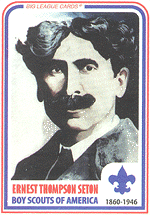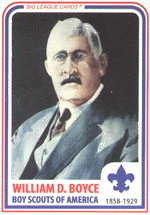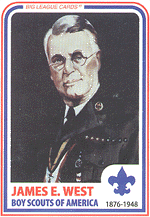
ROBERT S. S. BADEN-POWELL
As a youth, Robert Baden-Powell greatly enjoyed the outdoors, learning about nature and how to live in the wilderness. After returning as a military, hero from service in Africa, Baden-Powell discovered that English boys were reading the manual on stalking and survival in the wilderness he had written for his military regiment. Gathering ideas from Ernest Thompson Seton, Daniel Carter Beard, and others, he rewrote the manual as a nonmilitary nature skill book and called it Scouting for Boys.
To test his ideas, Baden-Powell brought together 22 boys to camp at Brownsea
Island, off the coast of England. This historic campout was a success
and resulted in the advent of Scouting. Thus, the imagination and inspiration
of Baden-Powell, later proclaimed Chief Scout of the World, brought Scouting
to youth the world over.
The UK Scout Association produced a factsheet on Baden Powell which is available
at
http://www.scoutbase.org.uk/library/hqdocs/facts/pdfs/fs295301.pdf
Additional documents on International Scouting's History can be found at http://www.scoutbase.org.uk/library/hqdocs/facts/index.htm#sec_66

ERNEST THOMPSON SETON
Born in Scotland, Ernest Thompson Seton immigrated to America as a youth in the 1880s. His fascination with the wilderness led him to become a naturalist, an artist, and an author, and through his works he influenced both youth and adults. Seton established a youth organization called the Woodcraft Indians, and his background of outdoor skills and interest in youth made him a logical choice for the position of first Chief Scout of the BSA in 1910. His many volumes of Scoutcraft became an integral part of Scouting, and his intelligence and enthusiasm helped turn an idea into reality.

DANIEL CARTER BEARD
Woodsman, illustrator, and naturalist, Daniel Carter Beard was a pioneering spirit of the Boy Scouts of America. Already 60 years old when the Boy Scouts of America was formed, he became a founder and merged it with his own boys' organization, the Sons of Daniel Boone. As the first national Scout commissioner, Beard helped design the original Scout uniform and introduced the elements of the First Class Scout badge. "Uncle Dan," as he was known to boys and leaders, will be remembered as a colorful figure dressed in buckskin who helped form Scouting in the United States.

WILLIAM D. BOYCE
In 1909, Chicago publisher William D. Boyce lost his way in a dense London fog. A boy came to his aid and, after guiding the man, refused a tip, explaining that as a Scout he would not take a tip for doing a Good Turn. This gesture by an unknown Scout inspired a meeting with Robert Baden-Powell, the British founder of the Boy Scouts. As a result, William Boyce incorporated the Boy Scouts of America on February, 8, 1910. He also created the Lone Scouts, which merged with the Boy Scouts of America in 1924.

JAMES E. WEST
James E. West was appointed the first Chief Scout Executive of the Boy Scouts of America in 1911. Although orphaned and physically handicapped, he had the perseverance to graduate from law school and become a successful attorney. This same determination provided the impetus to help build Scouting into the largest and most effective youth organization in the world. When he retired in 1943, Dr. West was recognized throughout the country as the true architect of the Boy Scouts of America.
Source:
02-211
1995 Printing
Fact Sheet
External Communications
1325 West Walnut Hill lane
P.O. Box 152079, Irving, Texas 75015-2079
Telephone 972-580-2000







